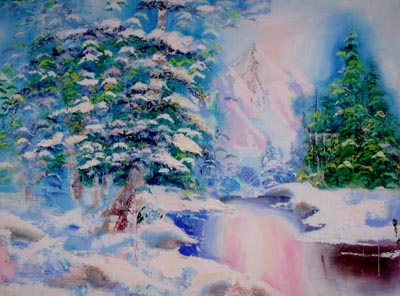 Mountain IC, 2002 Öl auf Leinwand, 220 x 170 cm Foto: Daniel Pfister Bettina Graf Toucanart Click for English text Bettina Graf (*1977 in Winterthur, lebt in Zürich) sammelt Supermarktbilder und setzt diese kleinformatigen, in Massenproduktion gefertigten Landschaftsmalereien in grosse Ölgemälde um. Sie übersteigert die als Kitsch verpönten Bilder in ihrer Umsetzung ein weiteres Mal durch exzessive Farbigkeit und durch die Pastosität des Farbauftrags. Das Kunsthaus Glarus zeigt die Bilder der jungen Künstlerin, die 2002 ihre Ausbildung an der Akademie der Bildenden Künste in Wien abgeschlossen hat, zum ersten Mal im Rahmen einer institutionellen Ausstellung. Bettina Graf malt nicht nach der Natur, sondern malt ein Bild eines Bildes, das sich den Anschein eines künstlerischen Werkes zu geben scheint. Sie sagt dazu: "Ein Gemälde besitzt naturalistische oder abstrakte Qualitäten, nur die Wirklichkeit hat reale Qualitäten. Je naturalistischer ein Gemälde wirkt, desto präziser entspricht die malerische Umsetzung der realen Dingwelt. Das in Asien hergestellte Landschaftsbild wird von mir nur deshalb naturalistisch wiedergegeben, weil ich es als realen Gegenstand erworben habe und es somit in die reale Dingwelt eingeteilt werden kann - die Wiedergabe ist ein Bild eines Gegenstandes, ein Bild eines Bildes. Es hat sich von der reellen Natur gelöst, beinhaltet aber meine Erinnerungen an die wirkliche Natur". Der serielle Herstellungsprozess (sie werden meist von mehreren Malern in einem Billiglohnland produziert) und die stereotypen Motive entlarven Bettina Grafs Bildquellen als kommerzielles Produkt. Kitsch - als Abbild einer illusionären Welt, in der Gefühle vorgetäuscht werden, unecht oder aus zweiter Hand sind - wird von der Künstlerin auch als Ausdruck von Sehnsüchten einer Gesellschaft verstanden. So steht hinter ihrem konzeptuellen, ironischen Spiel denn auch die Frage danach, wie ein perfektes Sehnsuchtsbild auszusehen habe. Die Tatsache, dass Sehnsuchtsbilder oft Bilder von unberührter Natur oder von romantisch erhabenen Naturszenerien handeln, wirft Fragen auf. Ist für einen Kunstlaien das "Bild an sich" immer ein Landschaftsbild? Gibt es so etwas wie archetypische Landschaftskompositionen? Lassen sich unter Umständen sogar kunstgeschichtliche Parallelen mit Kompositionen der Landschaftsmalerei des 19. Jahrhunderts finden? Und was bringt Menschen überhaupt dazu, gemalte Bilder besitzen zu wollen, wenn es ihnen doch nicht a priori um Kunst geht? Ausstellungsdauer: 16.5. - 1.8.2004 Oeffnungszeiten: Di - Fr 14 - 18 Uhr, Sa/So 11 - 17 Uhr Kunsthaus Glarus Im Volksgarten 8750 Glarus Telefon 055 640 25 35 Fax 055 640 25 19 Email office@kunsthausglarus.ch www.kunsthausglarus.ch Bettina Graf Toucanart Bettina Graf (born 1977 in Winterthur, lives in Zurich) collects supermarket pictures and transforms these small-format, mass-produced landscape paintings into large oil paintings. In her transformation of the pictures, which are scorned as kitsch, she exaggerates them even further through excessive colorfulness and through thick layering of paint. The Glarus Art Museum presents the works of the young artist, who completed her training at the Academy of Fine Arts in Vienna in 2002, for the first time in an institutional exhibition. Bettina Graf does not imitate nature, but rather paints a picture of a picture pretending to be a work of art. As she says herself, "A painting has naturalistic or abstract qualities; only reality has real qualities. The more naturalistic a painting appears, the more precisely the pictorial implementation corresponds to the real world of things. The landscape picture manufactured in Asia is reproduced naturalistically by me only because I have bought it as a real object and it therefore can be assigned to the real world of things - the reproduction is a picture of an object, a picture of a picture. It has separated itself from real nature, but it contains my memories of actual nature". The serial manufacturing process (the pictures are usually produced by multiple painters in a low-wage country) and the stereotypical motifs expose Bettina Graf's source images as a commercial product. The artist also understands kitsch - a portrayal of an illusory world in which feelings are feigned, false, or second-hand - as an expression of the longings of a society. Underneath her conceptual, playful irony therefore lies the question of what a perfect picture of longing should look like. The fact that pictures of longing often deal with untouched nature or romantically noble nature scenarios raises questions. For the artistic layperson, is the "image in itself" always a landscape image? Is there something like an archetypal landscape composition? Can art-historical parallels perhaps even be found with compositions of landscape painting in the 19th century? And for what reason do people want to own painted pictures in the first place if they are not a priori even interested in art? May 16 - August 1, 2004 |